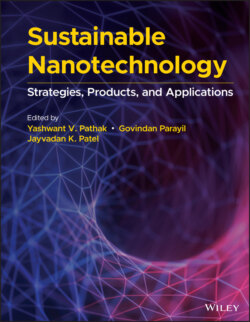Читать книгу Sustainable Nanotechnology - Группа авторов - Страница 17
1.2.1.1 Gold Nanoparticles
ОглавлениеIn comparison with other nanomaterials, the nanostructure of metallic nanoparticles is most flexible due to the synthetic control of their shape, size, structure, composition, assembly, and encapsulation, along with the tenability of their optical properties. Within these metals, GNPs are extremely useful in biomedical applications because their preparation time is shorter and the process is simpler than the others. Gold nanospheres can be prepared by reducing auric acid with different concentrations of sodium citrate for size variation. In addition, the citrate capping on the gold particles can be replaced with biomolecules such as DNA, peptides, and antibodies; they form covalent and noncovalent bonds with GNPs [13].
There are many applications of GNPs in cancer imaging and cancer therapy. The combination of GNPs and dynamic light scattering, a technique usually used for nanoparticle size analysis, enabled the analysis and detection of chemical and biological target analytes such as proteins, DNA, viruses, carbohydrates, and chemical and environmental toxins [14, 15].
With regard to treatment, photothermal therapy (PTT) using GNPs can initiate a hyperthermic physiological response in the tumor [16, 17]. The GNPs are able to convert light into heat, which can “melt” the targeted tumor. Gold, in particular, is useful in PTT because of its specificity. They can be administered to a local tumor area, which decreases the chances of its distribution to healthy cells, a problem with the conventional cancer treatment methods [18]. They can also be used to prevent migration of tumors to other areas of the body. In 2017, a study showed that GNPs targeting the nuclear membrane of cancer cells can increase nuclear stiffness and prevent cell migration and invasion. The nanoparticles trapped at the nuclear membranes can lead to overexpression of lamin A/C protein that leads to cell stiffness [19].
